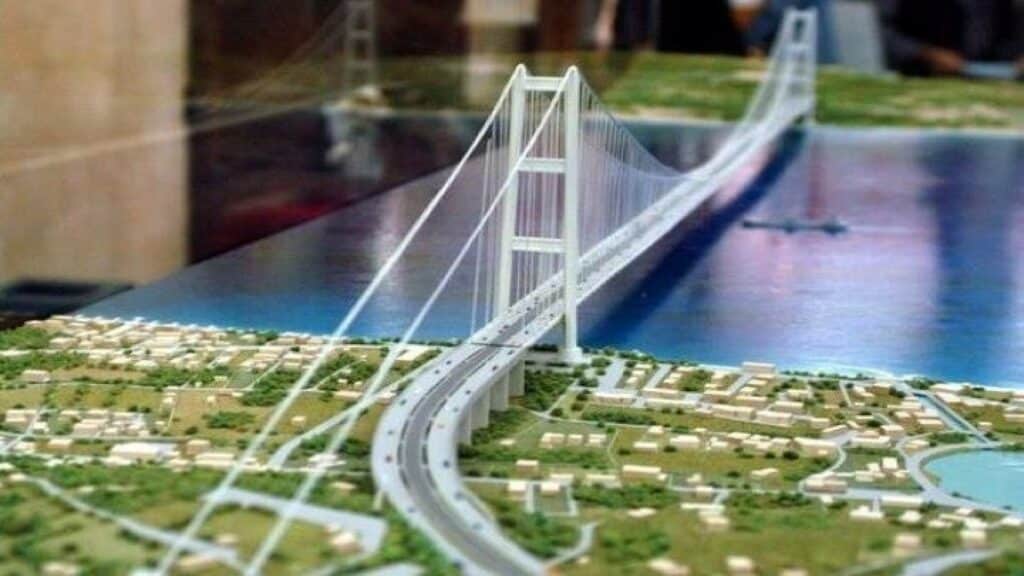Rome, Italy (Ports Europe) December 2, 2024 – Just over 9 billion euros in investments versus benefits of almost 11 billion euros with a net result of 1.8 billion euros that will flow into the Italian economy, at all levels, including those on the employment front. This was the top line of a report by Uniontrasporti.
The report is an in-depth study of the economic, social and environmental impacts of the Messina Strait Bridge project, a strategic infrastructure for Italy’s competitiveness in the European context. The study, commissioned by Unioncamere Sicilia from Uniontrasporti, and conducted with technical & scientific support from Openeconomics, presents the costs and benefits of the project for Italy.
The information was presented during a conference in Rome in the presence of technicians and the top management of the Società Stretto di Messina, the client of the work that, together with the general contractor, the old Eurolink consortium, will build the connection between Calabria and Sicily.
According to the study, during the construction phase, the work will be able to contribute 23.1 billion euros to the GDP, create 36,700 stable jobs, increase family incomes by 22.1 billion euros and feed the tax revenues into the state coffers with 10.3 billion euros.
The other numbers lined up by the report indicate 7,759 million minutes saved for crossing the strait, 2,580 million of CO2 not released into the air, 270 million euros cut from the operating costs of companies, 212 million euros saved due to the reduction of local pollution but also an outlay of 108 million euros due to the increase in accidents.
Tourism
The tourist aspect of the bridge is considered important as is its function in terms of transport, roads and railways. There are proposals for lifts in the two main towers and glass lookouts for tourists. Some estimates are around 500,000 tourists visiting the area annually to see the structure.
Territorial impact
The dossier also analyzed the territorial impacts, concluding that in addition to the two regions physically impacted by the work, the regions with the greatest benefits in terms of GDP are Lombardy, Lazio, Emilia Romagna and Veneto. This is due to the activation of the supply chains in the relative production areas.
Economic sectors
The economic sectors most affected by the construction site are manufacturing, construction and business services, while “as an indirect and induced consequence of the activated economic cycle, the main impacted sectors are those of personal services and public administration”. Railway investments are also important: in Sicily, Rfi reports, 25 billion euros will be spent, of which 72% (equal to 17.9 billion euros) has already been financed, while in Calabria the figures are increasing and 35.4 billion euros are expected, of which however only 37% (13.1 billion euros) has been financed.
The work, according to the study, will cost 13.5 billion euros, a figure that has already been circulating in the debate over the past few months around the Bridge and which is also confirmed by the CEO of Stretto di Messina, Pietro Ciucci, who speaks of “updates required by law”.
He says that “13.5 billion is the updated value and we are defining the agreements with all the different contractors, we are evaluating the requests presented by the various bodies and Service Conferences”, and it is a phase that “will be concluded soon”. Who, regarding the sensitive seismic issue, confirmed that “the towers do not rest on active faults with seismogenic potential”. Even Minister Salvini returned to the infrastructure, announcing the approval of the final project by December. “We are working on it – said the minister interviewed on Radio 1, “especially because, according to company estimates, it will create 120,000 jobs, not only in Sicily and Calabria but throughout Italy”.
Ports Europe Note:
Generally, these numbers appear highly positive with the project offering benefits in many areas of business and society. However, the numbers are huge and there are still real doubts about where the financing will come from. The European Union will be a contributor, but EU loans and grants come with very strict terms and conditions. Huge construction projects come with unexpected problems and issues.
Also, there have many encouraging statements from Minister of Infrastructure Matteo Salvini. Howver, there are still concerns that some key dates have not be fixed. This includes a date for Cipess to examine the final project. The approval of the final project for the project is foreseen by the “law by 31 December 2024 and therefore 2025 will be the year of the first activity on the territory”. This is what the CEO of Stretto di Messina Spa, Pietro Ciucci, said, speaking at the conference. Ciucci estimated the completion time of the project at eight years and “the updated cost to target” at 13.5 billion.
More Ports Europe news about the Strait of Messina Bridge project
Copyright (C) Ports Europe. All Rights Reserved. 2024.

